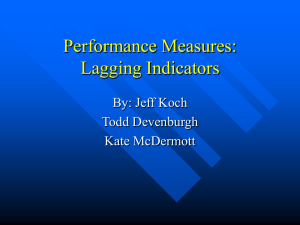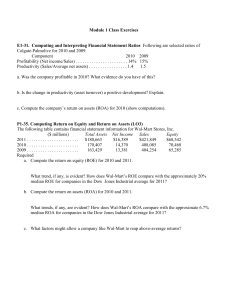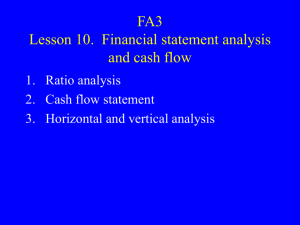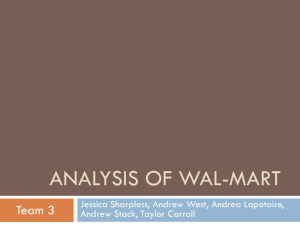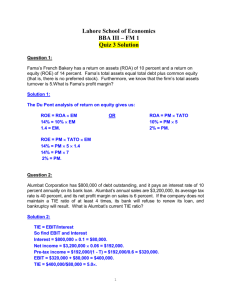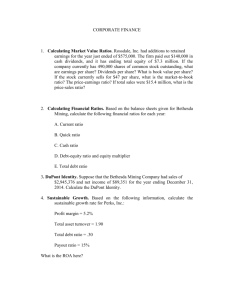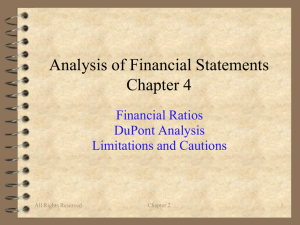Ch 19 Financial Statement Analysis
advertisement
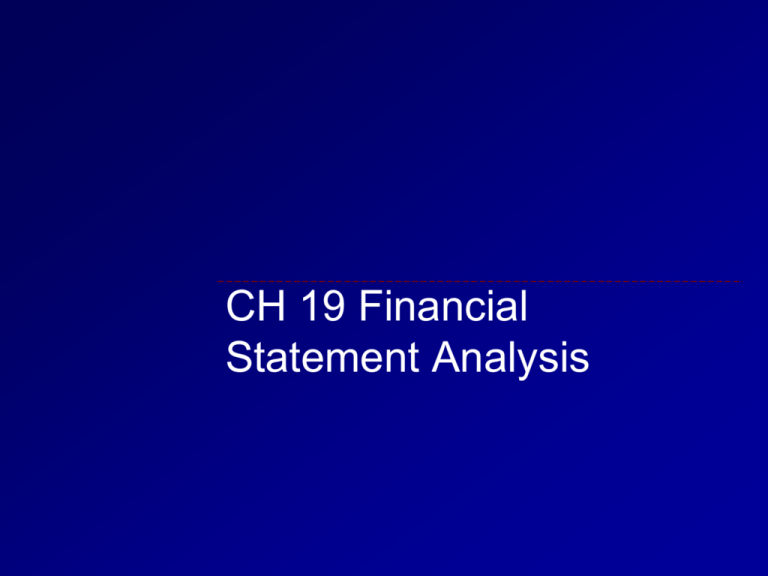
CH 19 Financial Statement Analysis Framework of Analysis Fundamental Analysis – Research to predict stock value that focuses on such determinants as earnings and dividends prospects, expectations for future interest rates, and risk evaluation of the firm Top-down approach (“Three-Step” Valuation Approach – Domestic and global economic analysis – Industry analysis – Company analysis 2 Investment Process 3 FINANCIAL STATEMENT ANALYSIS 4 Financial Statement Analysis Financial statement analysis can be used to discover mispriced securities. Financial accounting data are widely available, but – Accounting earnings and economic earnings are not always the same thing! 5 Financial Statements Income Statement: – Profitability over time Balance Sheet: – Financial condition at a point in time Statement of Cash Flows: – Tracks the cash implications of transactions. 6 Accounting Versus Economic Earnings Economic earnings – Sustainable cash flow that can be paid to stockholders without impairing productive capacity of the firm Accounting earnings – Affected by conventions regarding the valuation of assets Example: LIFO vs. FIFO Depreciation expense 7 Consolidated Statement of Income for Home Depot, 2012 8 Consolidated Balance Sheet for Home Depot, 2012 9 Statement of Cash Flows for Home Depot, 2012 10 Measuring Firm Performance 11 Measuring Firm Performance Manager responsibilities: – 1. Investment decisions – 2. Financing decisions Ratios used to show efficiency and profitability of these decisions: – ROA- income earned per dollar deployed – ROC- income earned per dollar invested (long term) – ROE net income realized by shareholders per dollar invested 12 Profitability Measures ROE measures profitability for contributors of equity capital. – After-tax profit/book value of equity ROA measures profitability for all contributors of capital. – EBIT/total assets 13 Past vs. Future ROE ROE is a key determinant of earnings growth. – Firm’s growth rate = ROE x Retention Ratio Past profitability does not guarantee future profitability. – Security values are based on future profits. – Expectations of future dividends determine today’s stock value. ROA and ROE are linked, but their relationship is affected by the firm’s financial policies. – One should pay attention the firm’s debt-equity mix and to the interest rate on its debt. 14 Financial Leverage and ROE ROE can differ from ROA because of leverage. Leverage makes ROE more volatile. Let t = tax rate and r = interest rate, then: Debt ROE 1 t ROA ROA r Equity 15 Financial Leverage and ROE, cont’d If there is no debt or ROA = r, ROE will simply equal ROA(1 - t). If ROA > r, the firm earns more than it pays out to creditors and ROE increases. If ROA < r, ROE will decline as a function of the debt-to-equity ratio. Debt ROE 1 t ROA ROA r Equity 16 Impact of Financial Leverage on ROE 17 Economic Value Added A firm should be viewed as successful only if – The return on its projects is better than the rate investors could expect to earn for themselves (on a risk-adjusted basis) in the capital market. EVA is the difference between return on assets (ROA) and the opportunity cost of capital (k), multiplied by the capital invested in the firm. EVA is also called residual income If ROA > k, value is added to the firm. 18 Example: Intel In 2012, Intel’s cost of capital was 7.8%. Its ROA was 13.9% and its capital base was $56.34 billion. Intel’s EVA = (0.139-0.078) x $56.34 billion = $3.44 billion 19 Ratio Analysis: Decomposition of ROE DuPont Method ROE = Net Profit x Pretax Profit Burden x EBIT (1) Tax Pretax Profit x x (2) Interest Burden x EBIT Sales (3) x x Sales Assets (4) x Assets Equity x (5) x Margin x Turnover x Leverage 20 Decomposition of ROA ROA= EBIT/Sales X Sales/Assets = margin X turnover Margin and turnover are unaffected by leverage. ROA reflects soundness of firm’s operations, regardless of how they are financed. 21 Decomposition of ROE ROE =Tax burden X ROA X Compound leverage factor Tax burden is not affected by leverage. Compound leverage factor= Interest burden X Leverage 22 Ratio Decomposition Analysis for Nodett and Somdett 23 Choosing a Benchmark Compare the company’s ratios across time. – Time-series analysis Compare ratios of firms in the same industry. – Peer group analysis Cross-industry comparisons can be misleading. 24 Time-Series Analysis 25 Time-Series Analysis Op Income / Sales for Enron 18 16 14 12 10 8 6 4 2 0 1984 1986 1988 1990 1992 1994 1996 1998 2000 26 Peer Group Analysis A. Profitability 1. Profit Margin ……………… 2. Return on Assets ………….. Saxton Company Industry Average 5.0% 12.5% 6.7% 10.0% 3. Return on Equity ………….. 20.0% B. Asset Utilization 4. Receivables turnover ……. 5. Average collection period…. 6. Inventory turnover ………... 7. Fixed asset turnover ………. 8. Total asset turnover ………. 11.4 32.0 10.8 5.0 2.5 Conclusion 15.0% Below average Above average due to high turnover Good 10.0 36.0 7.0 5.4 1.5 Good Good Good Below average Good C. Liquidity 9. Current ratio ……………… 10. Quick Ratio ……………….. 2.67 1.43 2.1 1.0 D. Debt Utilization 11. Debt to total assets ……….. 12. Times interest earned ……. 37.5% 11.0 33.0% 7.0 Good Good Slightly more debt Good 27 Peer Group Analysis 28 Peer Group Analysis 29 Differences between Profit Margin and Asset Turnover across Industries 30 Industry Differences Industry Turnoverprofit margin tradeoff Industries with high turnover such as groceries retail apparel tend to have low profit margins, while industries with high margins such as utilities tend to have low turnover. 31 Industry Differences 32 Summary of Key Financial Ratios 33 Summary of Key Financial Ratios 34 Summary of Key Financial Ratios 35 Summary of Key Financial Ratios 36 Summary of Key Financial Ratios 37 38 Ratio Analysis Which ratio measures the financial or credit risk? Which ratio measures the company’s ability to service its fixed interest payment? Which ratio measures the company’s ability to pay off short-term obligations like notes payables and accounts payables? Which ratio measures how well the company generates revenues and controls costs and expenses (i.e., overall operating effectiveness)? Which ratio measures the company’s ability to deliver the shareholder’s value? Which ratio measures the company’s market price relative to $1 of capital that was invested by shareholders? 39 Comparability Problems Accounting Differences – Inventory Valuation – Depreciation Inflation and Interest Expense Fair Value Accounting Quality of Earnings International Accounting Conventions 40 International Accounting Differences Reserves – many other countries allow more flexibility in use of reserves Depreciation – US allows separate tax and reporting presentations Intangibles – treatment varies widely 41 Adjusted Versus Reported Price-Earnings Ratios 42 The Graham Technique Rules for stock selection: – Purchase common stocks at less than their working-capital value. – Give no weight to plant or other fixed assets. – Deduct all liabilities in full from assets. 43


